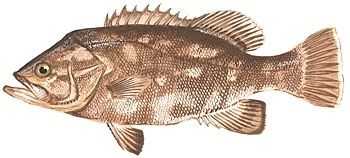Wreckfish

Species Details
Polyprion Americanus
Polyprionidae
Perciformes
Offshore, Deepwater, Wrecks
40 - 220 lbs.
38" - 83"
Wreckfish (Polyprion Americanus) Fish Description
Wreckfish – or popularly known as the Atlantic Wreckfish – is a deep ocean fish. The Wreckfish is a kind of fish that prefers loitering around on the ocean floor. The majority of the Wreckfish’s fins are spiny. The dorsal fin alone has two sections: one with eleven spines and the second section having one spine but linked to twelve other rays. Despite it being known as a ray-finned fish, the Wreckfish appears to have more spines than it does having rays.
The Wreckfish is also known as the Stone Bass. As a cousin to the Sea Bass, it does have some aesthetic similarities such as the dark slate color with dark blotches that allow it to blend with the seafloor. Another is the square-edged fins that are composed of soft rays. Its anal fin however has three spines right before the rays. The Wreckfish also has a large mouth similar to its Sea Bass cousins but is differentiated by the underbite it has.
Wreckfish Diet and Size
As a bottom-dwelling fish, Wreckfish like feeding on squids and cuttlefish. However, they also feed on octopuses and some crustaceans that they find dwelling alongside them. Similar to the Black Sea Bass, they can be quite opportunistic. One report came in of a Wreckfish devouring a small shark while it was feeding off a dead Swordfish.
Wreckfish can grow up to 6.9 ft and 220 lbs. However, the average size of an Atlantic Wreckfish is around 40-60 lbs and 2.5 to 4 ft long.
Interesting Facts about the Wreckfish
- Wreckfishes are usually solitary fish. However, they do congregate when they’re about to spawn.
- The Wreckfish was discovered by mistake!
- In an attempt to fish for Grouper and Bass in 1980, a fisherman pulled out a Wreckfish while trying to find his lost equipment.
- Wreckfish have a long-life span of 70 years.
- As juveniles, they are often hunted down by sharks and bony fish. But once they get older, Wreckfish become part of the top of the food chain.
- Wreckfish because of their popularity needed to have restrictions when fishing for them.
- Depends what state you’re in though if you’re planning to fish for some Wreckfish.
- Its scientific name, Polyprion, is a reference to its spine. In Greek, the word poly means “many” whereas prion means “saw”. So, it’s crudely translated as “many saws” which is what its spiny fins look like.
- Possibly, the multiple spines on the Wreckfish are what make it so intimidating to other fish.
- Its spines are so sharp that it may serve as their defense mechanism and weapon against other predators.
Wreckfish – Fishing Techniques: How to Fish for a Wreckfish
There is only one legal way to fish for a Wreckfish and it’s through Bottom Longlining.
Bottom Longlining is a technique where a boat puts out a rod which is marked by rigs and floaters. Then, from the floaters, a long line is cast down and held down by an anchor. The line then is extending far on the ground with hooks containing bait and is marked by another floater to estimate how far the line has reached. Another term for this kind of fishing is called Deep Dropping.
To attract those Wreckfish, you’ll need a lot of squid and cuttlefish. Octopus and crustaceans will do too. Wreckfish often stay amongst the crevices and rock formations so you’ll have to find a place where there’s a lot of rocky structures which is where they hide and wait until they find their prey.
Wreckfish Habitat and Distribution
Wreckfish love staying in caves. They choose places with rocky substrates and areas with a lot of boulders scattered around. They also prefer reefs and shipwrecks which can really cause your line to snag if you’re not careful! These caves can either be natural rock formations or formations formed by falling debris left behind by ships.
When fishing for a Wreckfish and using the Bottom Longlining method, always make sure that the way you set it up doesn’t get snagged when you start reeling it up. Usually when fishing for a Wreckfish, what destroys people’s chances of catching one is when the line gets snagged and snapped, causing people to lose their catch. But don’t expect to get many in one go! These guys are solitary fish. Therefore, they won’t just pop out even though their fellow Wreckfish is there.







